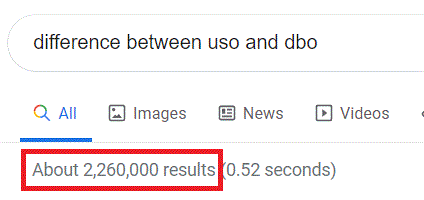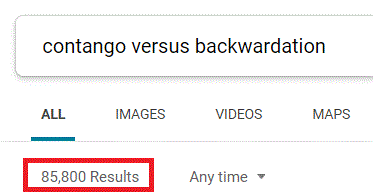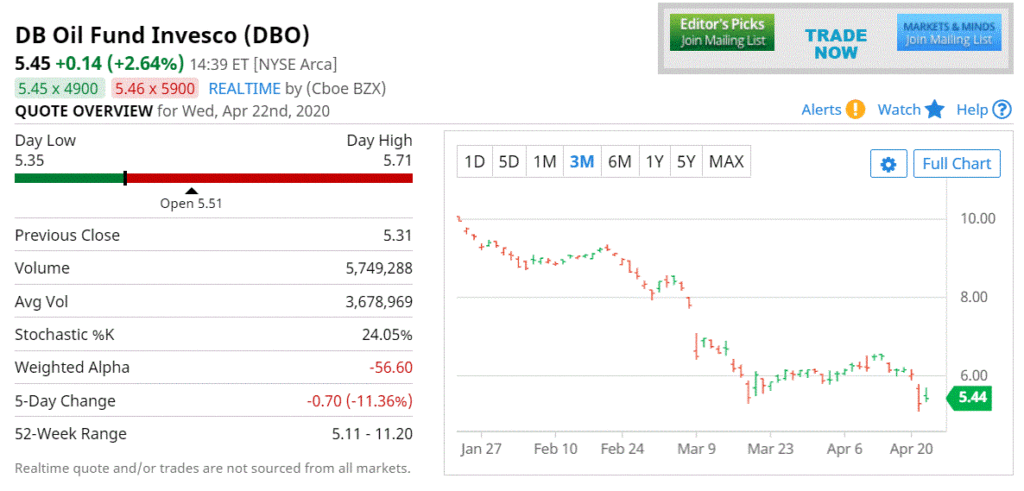As strange as it may sound, I typically avoid trying to be “topical.” In other words, instead of writing about “the news of the day”, I tend to wander the darker corridors of “a market-addled mind.” Which is why for example, I didn’t write a long piece discussing the fact that March 2020 crude oil futures fell to a negative price. I simply felt that the 246,000,000 other articles on the topic covered it fairly thoroughly.

Figure 1 – Crude oil futures fell to a negative price (have you heard?)
I did however write about ticker DBO – one of several ETFs that purportedly are designed to track the price of crude oil. Two others that come to mind are USO and USL. Each is traded in a different manner. I have never really written about this as I feel that the 2,260,000 other articles on the topic covered it fairly thoroughly.

Figure 2 – Differences in oil ETFs
However, given the amount of trading going on in ticker USO, apparently no one is reading the other 2,260,000 articles on the topic so for the benefit of JOTM readers I will spell it out as succinctly as possible.
DO NOT BUY USO!!!!
Can’t get much more succinct than that. The problem with USO is known as “contango” – the problem with writing about contango is that as soon as people read that word their eyes start to get heavy, their head starts to hurt and they instantly think of something (anything) else that they’d rather be thinking about.
Which is really the only plausible explanation as to why anyone would buy USO at this point.
Now a slightly longer explanation involving tickers USO and DBO. Each hold crude oil commodity futures – the difference is in which contract months they hold and the amount of trading volume for each. For the record, ticker USO got into the minds of traders first and is far and away the most actively traded – which, as we will see in a moment, makes almost no sense for people who want to play the long side of crude oil.
The Difference as Succinctly as Possible
*USO holds the nearest actively traded crude oil futures contract month and DBO does not.
Before even trying to explain why this matters see Figure 3 and note that the price for each successive contract month is higher than the month before it. This is important. This is the definition of “contango’, i.e., future months are more expensive than nearer months. The opposite situation is referred to as “backwardation.” WAKE UP AND DO NOT STOP READING!!!

Figure 3 – Crude oil futures prices (Courtesy: www.BarChart.com)
So, ticker USO simply “rolls” from one month to the next. Because each month is more expensive than the last it costs more each month to buy a given contract. This depresses the price of USO over time, and “No”, I am not going to explain it any further than that! If you wish a more detailed explanation, please refer to these 85,000 other articles on the topic.

Figure 4 – Contango versus Backwardation
An Even More Detailed Look at USO and DBO
To make (my) life simpler I am going to lift text directly from this article at www.Nasdaq.com.
USO
This is the largest and actively traded ETF in the oil space with AUM of $3.96 billion and average daily volume of around 527.15 million shares. The fund provides investors with exposure to front-month oil futures contract traded on the NYMEX. The expense ratio comes in at 0.74%.
As traders need to roll from one futures contract to another in order to avoid delivery, the fund is susceptible to roll yield. Notably, roll yield is positive when the futures market is in backwardation and negative when the futures market is in contango. Basically, if the price of the near month contract is higher than the next month futures contract, this is backwardation and the opposite holds true for contango.
Also, from http://www.uscfinvestments.com/uso , they state:
The United States Oil Fund® LP (USO) is an exchange-traded security designed to track the daily price movements of West Texas Intermediate (“WTI”) light, sweet crude oil. USO issues shares that may be purchased and sold on the NYSE Arca.
The investment objective of USO is for the daily changes in percentage terms of its shares’ NAV to reflect the daily changes in percentage terms of the spot price of light, sweet crude oil delivered to Cushing, Oklahoma, as measured by the daily changes in price of USO’s Benchmark Oil Futures Contract, less USO’s expenses.
USO’s Benchmark is the near month crude oil futures contract traded on the NYMEX. If the near month futures contract is within two weeks of expiration, the Benchmark will be the next month contract to expire. The crude oil contract is WTI light, sweet crude oil delivered to Cushing, Oklahoma.
USO invests primarily in listed crude oil futures contracts and other oil-related futures contracts, and may invest in forwards and swap contracts. These investments will be collateralized by cash, cash equivalents, and US government obligations with remaining maturities of two years or less.
If you want to know exactly what USO holds, see this link http://www.uscfinvestments.com/holdings/uso
DBO
Unlike USO, this ETF follows the DBIQ Optimum Yield Crude Oil Index Excess Return plus the interest income from the fund’s holdings of primarily US Treasury securities. The Index employs the rules-based approach when rolling from one futures contract to another in order to minimize the effect of contango.
Instead of automatically rolling into the near-month oil futures contract, the benchmark selects the futures contract with a delivery month within the next 13 months, when the best possible “implied roll yield” is generated. As a result, DBO potentially maximizes the roll benefits in backwardated markets and minimize the losses from rolling in contangoed markets.
If you want to know exactly what DBO holds, see this link https://www.invesco.com/us/financial-products/etfs/holdings?ticker=DBO
Why This All Matters
Note the price action for USO and DBO sometime during the day on 4/22/20

Figure 5 – Ticker USO (lots of people buying, lots of people losing money)

Figure 6 – Ticker DBO (not as many people buying, but making money – at least today – versus buyers of USO who are losing money today)
Note:
*Both ETFs hold crude oil futures
*USO is DOWN -8.9% on the day
*DBO is UP +2.64% on the day
YET:
*USO has traded over 371 million shares today
*DBO has traded just under 6 million shares today
So the question is “why are people buying USO?”
Historical Performance
First, please make sure you are sitting down. Since 12/31/2007 USO has lost over 96% of its value. DBO has lost “only” 83% of its value.
This raises the question, “why is anyone buying either one of these ETFs?” For the record I addressed this to some degree in this article. Bottom line:
*Chances are good that crude oil will not be dirt cheap forever
*Whenever and wherever the bottom may be, it may prove to be a once in a generation buying opportunity
*If I do decide to play the long side of crude oil AND crude oil futures are still in contango, I sure the h%^ am going to buy DBO and NOT USO.
*Also, for the record, another alternative might be ticker USL.
For more information please see these 45,500 articles.

Figure 7
Jay Kaeppel
Disclaimer: The information, opinions and ideas expressed herein are for informational and educational purposes only and are based on research conducted and presented solely by the author. The information presented represents the views of the author only and does not constitute a complete description of any investment service. In addition, nothing presented herein should be construed as investment advice, as an advertisement or offering of investment advisory services, or as an offer to sell or a solicitation to buy any security. The data presented herein were obtained from various third-party sources. While the data is believed to be reliable, no representation is made as to, and no responsibility, warranty or liability is accepted for the accuracy or completeness of such information. International investments are subject to additional risks such as currency fluctuations, political instability and the potential for illiquid markets. Past performance is no guarantee of future results. There is risk of loss in all trading. Back tested performance does not represent actual performance and should not be interpreted as an indication of such performance. Also, back tested performance results have certain inherent limitations and differs from actual performance because it is achieved with the benefit of hindsight.


Incorrect. That is not how USO works.
jy, thanks for the comment. I agree that my statement that USO holds 100% in the near contract month was a misstatement. I added some text from USCF Investments directly and a link to the actual holdings for USO. In any event, the real point I am trying to make is that contango is a huge problem for USO. Which I think is a fair statement (if not an understatement). Take Care, Jay